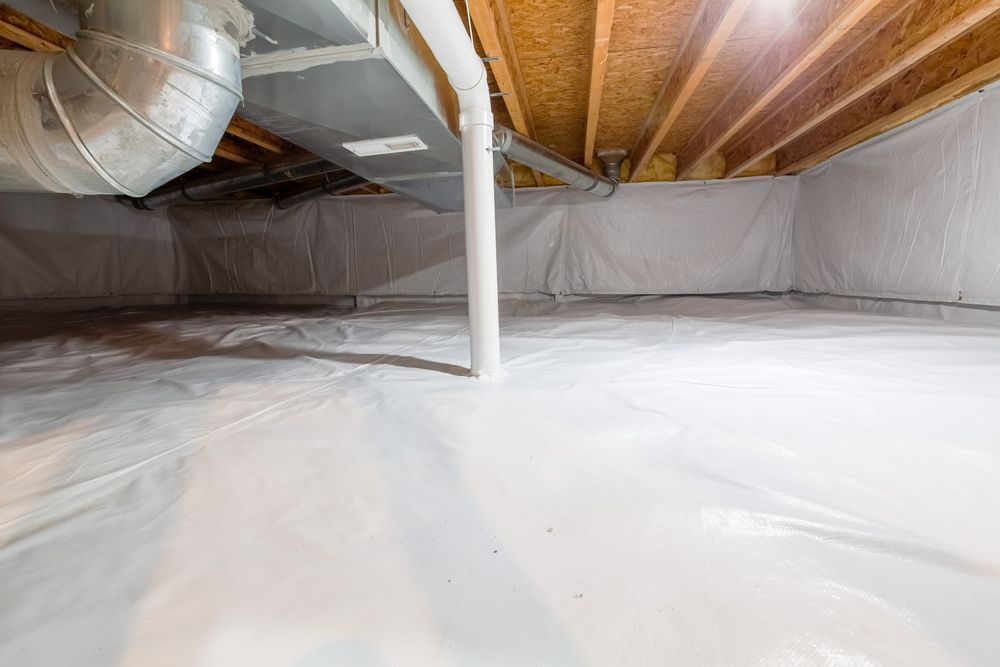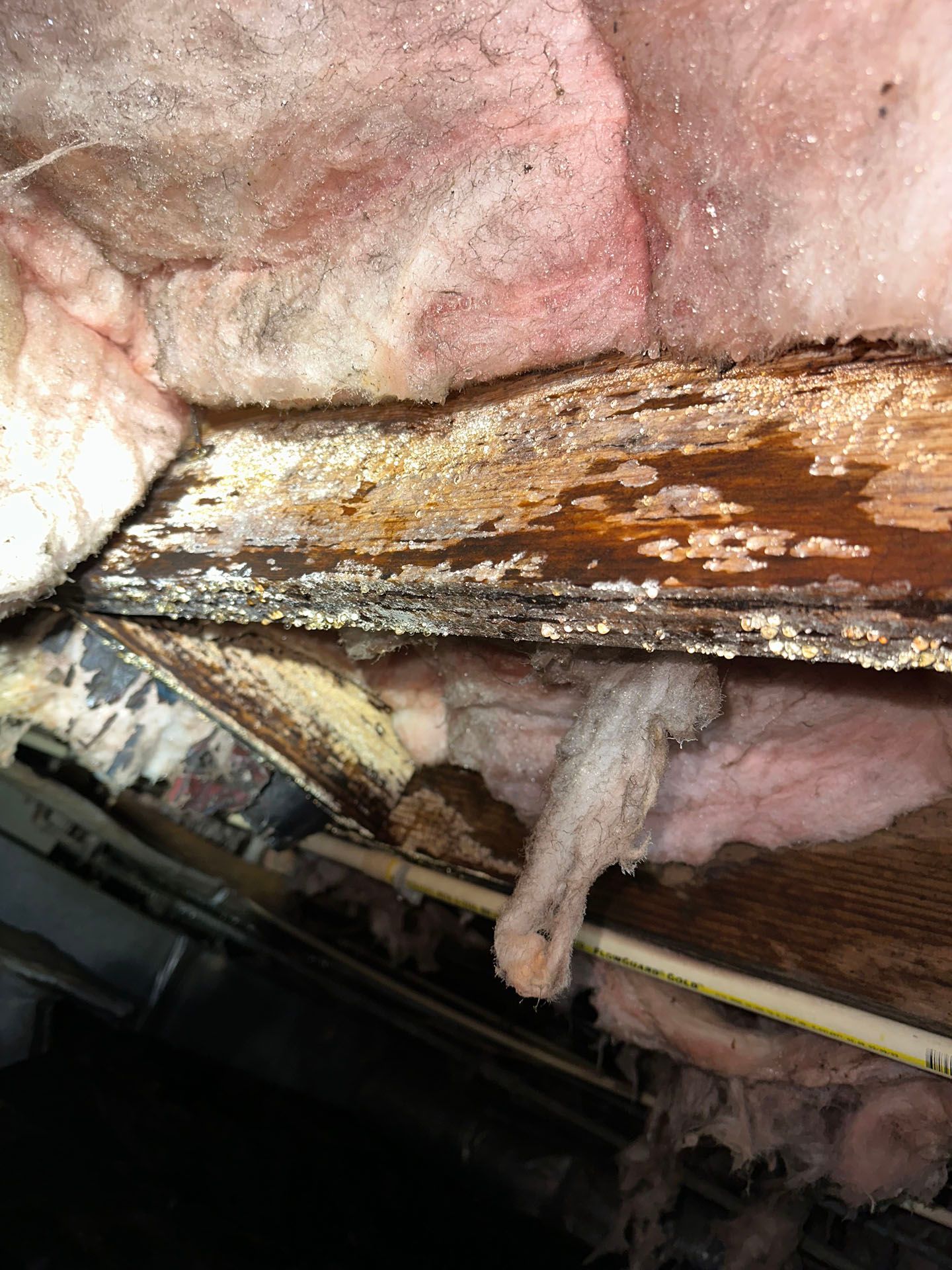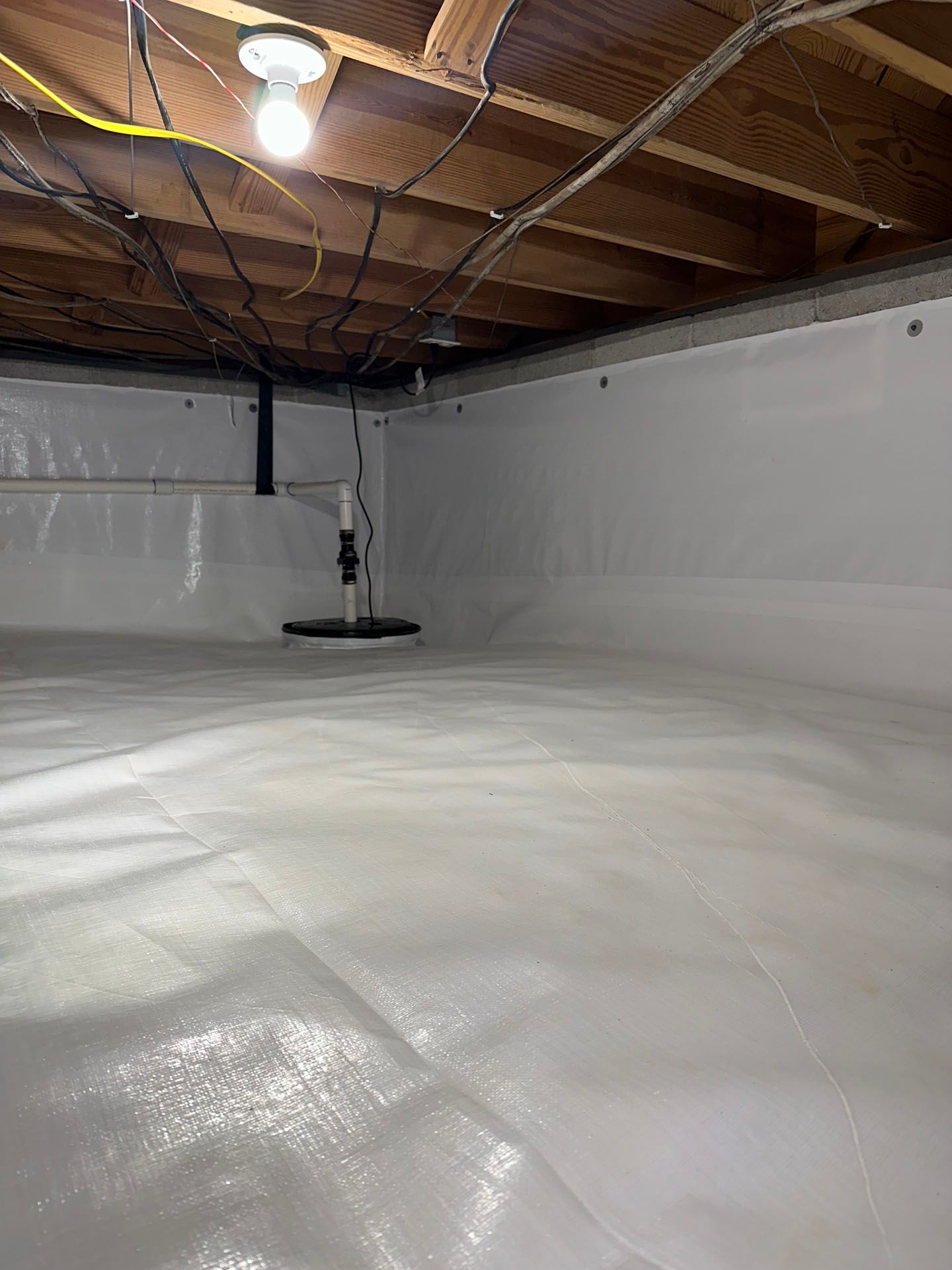Huntsville, Alabama

Claim Your FREE Crawl Space Inspection Today!
Sawyer Williams: 256-727-4422
Schedule Your Free estimate!
No-Obligation, Free Inspections
No-Obligation Free Estimates
We Warranty All of Our Work
100% Satisfaction Guaranteed
The question of crawl space encapsulation has been on the minds of many homeowners lately. Is it worth it? Will it help with decreasing moisture levels and potential mold growth? We're here to provide you with all the answers to the questions and concerns you may have. Through this blog post, we'll discuss whether crawl space encapsulation is really necessary and how to do it. So stop what you're doing and read on to find out more.
Quick Explanation of Key Points
Crawl space encapsulation can be beneficial for many homeowners, as it can help improve the air quality in your home and prevent humidity and moisture from entering the living spaces. However, it may not be necessary for certain homes, so it is important to speak to an expert and find out what is best for your individual situation.
Signs That Crawl Space Encapsulation Is Necessary
In order to know if crawl space encapsulation is necessary, it is important to understand the signs that indicate an encapsulated crawl space is needed. These include moisture and water intrusion, pest infestation, mold growth or other issues related to humidity levels.
Moisture and water intrusion in a crawl space can cause wood rot, as well as create other structural problems or lead to the growth of mold and mildew. Uncontrolled moisture can also promote high indoor humidity levels which can in turn damage belongings and increase energy costs. If there are trees or shrubs on the property too close to the foundation, this can be a sign that water intrusion is likely due to root systems expanding into cracks in the slab.
Pests such as termites, spiders, rodents and other animals seek out moist environments and can quickly overrun any unprotected home. Rodents bring with them dirt, droppings and urine which are unhealthy for occupiers of the home. If signs of pests are observed this means there is likely excessive moisture present that must be addressed with an encapsulated crawl space.
Mold and mildew in a crawl space indicates excess moisture from either flooding or poor ventilation throughout the year. This excess moisture will linger in areas it penetrates leading to household health complications such as asthma, allergies and even permanent respiratory damage if not addressed promptly and properly with an insulation barrier system that seals in airand watertight conditions.
The debate concerning whether or not crawl space encapsulation is necessary often centers around cost versus value of prevention. However, it should be noted that with proper maintenance and regular inspections this process can extend the life of a home’s foundation system while protecting against costly problems down the road like those mentioned above. Considering these factors makes it easier to understand why many homeowners opt for encapsulating their home’s crawl spaces.
Therefore, if any combination of the signs discussed above are present then encapsulation is necessary in order to protect from further damage and costly repairs in the future. With this knowledge as context, we now turn our attention to discuss another key element: moisture and water intrusion.
Moisture and Water Intrusion
Moisture and water intrusion are two of the primary causes behind crawl space decay. Without adequate protection, moisture and water can build up in the crawl space due to rain, melting snow, condensation, and insufficient drainage. Inadequate drainage can lead to pooling water that seeps into joists, subflooring, insulation, and other exposed areas of the foundation. This in turn can cause mold and mildew growth, rot, decay, structural damage and even insect or rodent infestations.
Encapsulating and sealing off the crawl space from moisture and water intrusion is critical to maintaining a healthy living environment. This can be achieved through a variety of methods including installing vapor barriers on the floor and walls of the crawl space, installing dehumidifiers or sump pumps for wetter environments, adding vents for ventilation, sealing access points where air or water may come through (such as through vents on the outside walls), installing plastic sheeting along all sides of the wall, as well as implementing trench drains or perimeter drains around the exterior of the home.
The argument could be made that some homeowners may not need to go to such lengths as they may already have adequate protection against water and moisture in their crawl space. There is also the argument that encapsulation is unnecessary if homeowners do not intend to use their crawl spaces for storage or living space. Nevertheless, proper waterproofing should always be considered part of an overall maintenance program regardless of whether or not home owners plan to use it as a livable space. The risk of moisture damage is real and every homeowner should take due diligence in preventing it from occurring in their home.
Leading into the next section about: "High Humidity Levels”; It is important to understand how high humidity levels caused by excess moisture impacts crawl spaces . . .
High Humidity Levels
High humidity levels in the crawl space environment can be a major problem. High humidity promotes the growth of mold, mildew, and rot, which can contribute to structural damage and cause health issues for those living in the home. Additionally, high humidity levels can increase indoor air pollution by making contaminants more airborne.
On one hand, some homeowners may want to replace costly crawl spaces with waterproof membranes or vapor barriers instead of investing in encapsulation. While vapor barriers may help reduce humidity levels, they are not a long-term solution since they do not fully address the underlying problem. Furthermore, while simply keeping the area dry may seem like a low-cost option, it is often only effective in controlling the moisture that comes from rain or water flooding the crawl space, rather than other sources of moisture such as groundwater or air leaks.
On the other hand, crawl space encapsulation can go a long way in addressing many different sources of high humidity and controlling overall moisture in your home. It prevents humid air from entering the crawl space and keeps out things like soil gases and condensation by creating an airtight barrier between the ground and your home. By selecting proper materials for the encapsulation process–such as polyethylene sheeting–you can ensure that your crawl space remains dry and healthy for years to come.
To get the most out of encapsulating your crawl space, it is important to understand what is causing high humidity levels and how you can reduce their effects. Taking steps such as using dehumidifiers, insulating pipes and ducts in the crawl space, sealing off any leaks around windows or doors, blocking water from coming into your home through gutters or downspouts, and more can help keep your home’s humidity level at an acceptable range.
For homeowners looking to protect their homes from high humidity levels, crawl space encapsulation is invaluable. Not only will it help keep your home safe from potential dangers but it also comes with numerous other benefits to boot – which we will cover in the next section all about the Benefits of Crawl Space Encapsulation.
- According to a study published by the American Society of Home Inspectors, crawl space encapsulation can reduce moisture buildup in a home by an average of 70%.
- Crawl space encapsulation has been found to be an effective solution for decreasing energy costs due to improved insulation.
- Studies have shown that crawl space encapsulation is an effective tool for reducing mold growth which can cause health issues including allergies, respiratory problems, and skin irritation.
Benefits of Crawl Space Encapsulation
Crawl space encapsulation is an effective and efficient way to prevent moisture and water damage in the home as well as energy loss. A crawl space is typically located beneath the home allowing access while also providing ventilation, which often results in inefficient energy costs due to outside temperatures being easily transferred indoors. The benefits of opting for a crawl space encapsulation are numerous, with improved air quality, enhanced structural integrity, the prevention of mold growth, and improved energy efficiency being just some of the advantages.
One of the biggest benefits of encapsulating your crawl space is that it should help improve air quality throughout your home. If proper sealing isn’t done when a traditional polyethylene vapor barrier is installed in the crawl space, airborne particles from dirt, dust, pollen and other irritants can be drawn up through the vents into your living areas. However, when you properly score your walls and floors and correctly install an encapsulating wall you create a ‘clean-room’ area because nothing can enter or leave your home from underneath.
Besides improving air quality throughout your home, Encapsulating your crawl space will also improve its structural integrity. This is because encapsulation creates a barrier between your floor joists and the high humidity levels found underneath them. Since these high levels can cause rot eventually leading to major structural damage if not treated properly, having an encapsulation system in place can go a long way towards keeping that moisture away so that it doesn’t degrade over time. Additionally, because less air will reach all of the wood components throughout your home, they will need less frequent maintenance.
Encapsulating one’s crawlspace also helps to protect against mold growth since mold thrives in environments with excess moisture and humidity. Without proper ventilation or insulation this could become very commonplace in spaces like a poorly maintained crawlspace but with an encasement properly sealed off those conditions are much less likely to exist destroying one of mold’s primary breeding grounds indoor allergens which help reduce asthma attacks and other respiratory issues.
Finally one of the biggest potential benefits associated with crawlspace encapsulation is improved energy efficiency during both winter & summer months. By insulating them with solid foam board insulation panels it will drastically reduce heat transfer into/out-of your living quarters thus resulting in lower monthly energy costs since heating and cooling systems won't have to regularly cycle-on/off protect against drastic temperature changes making them much more efficient than before as they're no longer battling against mother nature's changes outside.
Overall by carefully considering whether or not you want to opt for installation of an encapsulated system you'll be sure to reap many rewards including improved air quality & structural integrity regaining control over excessive moisture levels reducing potential cases of mold growth amongst other things along with improved heating & cooling capabilities - all helping boost overall energy efficiency! To further discuss these advantages we must now take a look at how exactly Improved Heating & Air Conditioning play into this equation..
Top Takeaways
Crawl space encapsulation is an effective and efficient way to prevent moisture, water damage, and energy loss in the home. Benefits include improved air quality, enhanced structural integrity, prevention of mold growth, improved energy efficiency, reduced heat transfer into/out-of the living quarters, and lower energy costs. This process involves carefully sealing the crawlspace using a polyethylene vapor barrier and foam board insulation panels for improved heating and air conditioning.
Improved Heating and Air Conditioning
When it comes to improving heating and cooling in a structure, crawl space encapsulation can make a major difference. Many homes today have issues with drafts or room temperatures that just never seem to get warm or cool enough. By installation of a barrier over the crawl space, such issues can be eliminated.
On one hand, sealing off the crawl space from outside air keeps conditioned air from escaping and reduces drafts. This is especially helpful during extreme temperature weather conditions, when the flow of air in and out of the sealed area helps maintain more consistent climates in other rooms of the house. On the other hand, an open, unsealed crawl space can produce humidity problems which encourage mold growth and create potential health hazards due to air infiltration.
In addition to keeping pest out, an enclosed space can be insulated to improve energy efficiency throughout the entire home by keeping heated and cooled air contained in the living spaces where it is needed most. In this way, installing a vapor barrier in the crawl space will help reduce energy costs as well as decrease risk of mold development or pests entering through gaps in foundation walls or poorly installed plumbing connections.
With proper installation and maintenance of a sealed tightly barrier for your crawl space, you can improve heating and cooling efficiency within your home while avoiding costly repairs caused by excess moisture buildup or hazardous drafts within occupied areas. The next section will further discuss the process of encapsulating your crawl space and its benefits on your energy bill and home's overall health.
Crawl Space Encapsulation Process
Crawl space encapsulation is a process of sealing off the home’s crawl space from the outside environment. To properly encapsulate a crawl space, the contractor must use materials such as heavy-duty plastic and a variety of insulation products. These materials are applied to all walls, floor, and ceiling surfaces in order to create a barrier, keeping moisture out and preventing air leaks.
The main debate on whether this process is necessary or not has to do with proactively taking steps against potential problems lower-level environments can cause homes. Those who argue for crawl space encapsulation point out that it can be beneficial in mitigating issues such as water damage, mold growth, pest infestation, and structural corrosion. On the other hand, some people argue that crawl spaces are sealed off enough already that additional measures are unnecessary or unneeded. Additionally, they may argue that it can be cost prohibitive to invest in a long-term solution that could potentially repay itself through improved energy efficiency.
Ultimately, the decision to proceed with or without this type of project depends on the homeowner’s individual circumstances and needs. Despite both sides of the argument being valid points to consider, it’s important to understand that crawl space encapsulation provides many benefits that can help mitigate health hazards and extend a home’s lifespan. Understanding exactly how this process works can help inform better decisions on whether it’s worth undertaking or not. With this in mind, let's move on and discuss plastic coverings and vapor barriers in greater detail.
Plastic Coverings and Vapor Barriers
When it comes to crawl space encapsulation, plastic coverings and vapor barriers are often the first step in this process. This is an effective way of preventing moisture from entering the area, thus protecting the structure of the building. The material used for these coverings and barriers should be rot-proof and waterproof, yet breathable enough to allow any minor amounts of moisture out of the space. They can also provide protection against pests such as rodents or insects that could otherwise make their way into your crawl space.
The effectiveness of plastic coverings and vapor barriers depends largely on installation technique. If not installed correctly, they can still allow moisture through as well as impede air flow into the crawl space by trapping it under the material. Properly installed, however, plastic coverings and vapor barriers provide a layer of protection against moisture entering the crawl space without completely sealing off airflow.
On one hand, this layer of protection is necessary in order to keep humidity levels low in order to prevent mold growth but on the other hand insulation can be compromised if there is too much condensation trapped between the barrier and insulation causing further damage. Therefore it is important to strike a balance between ventilation and water proofing when installing a plastic barrier or coverings in any crawl space or basement area.
In conclusion, plastic coverings and vapor barriers are a necessity for properly encapsulating a crawl space. However, careful consideration must be taken when deciding on material types and techniques for installation in order to ensure that proper protection is provided without sacrificing ventilation or insulation. With that said, it’s time to move on to the next step of appropriately sealing foundation walls and floors to complete the encapuslation process.
Sealing Foundation Walls and Floor
Sealing the walls and floor of the crawl space is vital in providing a barrier from outside elements that can cause harm to the home. The goal of sealing foundation walls and floors is to prevent water damage, rodents, insects, musty odors, and more from entering the structure. Coding may vary by region, but generally involves coverage for the interior foundation walls of about 6 feet up from the ground with a water-proofing membrane that also acts as a vapor barrier. Similarly, covering crawl space floors with a vapor barrier helps shield from moisture from below and unwanted pests.
When considering whether or not to seal foundation walls and floors, the potential benefits must be weighed against potential risks. On one hand, water and moisture can still enter through other access points, while if not installed properly it can lead to mold growth due to trapped air and lack of ventilation. To reduce this risk when installing waterproofing and vapor barriers it is important to follow all guidelines set forth for proper installation by experts in sealing foundation walls and floors.
Now that we have discussed sealing foundation walls and floors, let's move on to discuss how crawl space encapsulation prevents problems in the next section.
How Crawl Space Encapsulation Prevents Problems
Crawl space encapsulation prevents significant problems by creating an environment in which unwanted moisture, pests, and mold cannot live. This process seals off the dirt floors and walls of the crawlspace with a heavy-duty plastic to form an airtight barrier that stops outside air from entering the area. In addition, any existing insulation is replaced with more capable materials such as rigid foam boards to better insulate the space and reduce ventilation.
This process can significantly improve air quality and energy efficiency within a home as less humidity is able to get inside, rodent infestations are prevented, and outside contaminants are kept out. To top it off, if done properly, no additional maintenance will be needed after dealing with a problem the once.
Proponents of crawl space encapsulation argue that it provides tremendous health benefits by eliminating moisture which can cause mold growth or insect infestations. This can improve indoor air quality and reduce the risk of serious illnesses caused by breathing in contaminated or unhealthy air, especially for those with allergies or respiratory issues. Additionally, it increases the energy efficiency of homes since heat is retained better within an insulated space as opposed to one that isn’t properly sealed off from air leakage.
On the other side of the argument, critics point out that some people may find himself paying too much for too little gain. Financially speaking, full encapsulation can be quite expensive when compared to the cost of simply replacing insulation in the area or sealing certain vents with spray foam sealant. Also, owners may not find enough returns on their investment depending on how often their home faces water damage or pest infestations before encapsulation and after encapsulation.
At the end of the day, deciding whether crawl space encapsulation is necessary comes down to individual preferences and needs. Those who already have experience with cellar water problems might benefit greatly while others may be content with just doing minor repairs and upgrades every now and then. Ultimately it's up to you to weigh both sides of this debate before making a decision on what’s best for your home’s climate-controlled environment.
Final Thoughts on Crawl Space Encapsulation: Deciding whether crawl space encapsulation is right for your home is a complex decision that requires careful consideration of factors including budget, lifestyle needs, and potential health risks due to inadequate ventilation or moisture infiltration. It is important to research various solutions for each situation as there are often multiple courses of action available depending on personal preference and need. In any case, we recommend consulting a professional before committing to any specific course of action in order to ensure safety, proper installation methods and long-term cost savings in running your home efficiently.
Final Thoughts on Crawl Space Encapsulation
In summary, there are many advantages to crawl space encapsulation and few drawbacks, which makes it a sound investment for homeowners. The primary benefit is that crawl space encapsulation helps prevent moisture infiltration into the home’s structure, preventing issues like mold, wood rot, condensation, and other structural damage. Additionally, encapsulation also helps conserve energy by improving insulation and sealing off conditioned air from escaping.
On the other hand, it is important to realize that not all homes will benefit from encapsulating the crawl space. Homes in colder climates where freezing temperatures occur may still need some form of ventilation to prevent frost formation within the space. Furthermore, if there is existing structural damage or water infiltration prior to installation, repairs may be necessary prior to installing the encapsulation system. Lastly, crawl space encapsulation can be expensive depending on the size of the area and might not be worthwhile for certain homeowners.
Overall, crawl space encapsulation can prove to be a valuable investment for homeowners looking for a way to keep their home safe from potential moisture and damage issues. However, as with any major construction project such as this one, it is important to weigh the cost versus benefits and determine whether or not it is right for your individual needs. Be sure to contact a certified professional with experience in crawl space installation who can help navigate through the process and make an informed decision on if this type of project is necessary.
Answers to Common Questions with Explanations
What is the cost of crawl space encapsulation?
The cost of crawl space encapsulation can vary depending on the size and complexity of the space, as well as the specific materials used. Generally, an average crawl space encapsulation project may range anywhere from $2,500 to $8,500, with the majority of projects costing between $3,500 and $6,000. However, higher-end encapsulations may cost up to $15,000.
Crawl space encapsulation costs more upfront than traditional methods like installing a vapor barrier or fixing cracks in the foundation walls. However, over time it has proven to be more cost-effective due to its long-term benefits. These include reducing energy costs by making the home more airtight and insulated, reducing pest infestations, controlling humidity levels and preventing mold growth.
Overall, crawl space encapsulation costs are worth considering for any homeowners looking to reduce long-term energy costs and improve the comfort and health of their environments.
What are the drawbacks of crawl space encapsulation?
The primary drawback of crawl space encapsulation is the cost associated with it. Depending on the size of your crawl space, it can require a substantial commitment of both time and money in order to properly complete the encapsulation process. Additionally, if not done correctly, or by an experienced contractor, there is no guarantee that your crawl space will be completely sealed from water or air leaks. This could put you at risk for mold or mildew growth if the humidity levels inside your home are not kept at appropriate levels. Finally, some individuals believe that inadequate ventilation can be another potential drawback to crawl space encapsulation; however, this can easily be addressed by installing a vent fan in the area of the encapsulated space that needs additional air flow.
What tools do I need for crawl space encapsulation?
For crawl space encapsulation, you will need several essential tools in order to properly complete the process. Some of the most important tools include a measuring tape, a pair of scissors, a hammer and nail set, air duct sealing tape, sealant caulk, rigid foam insulation board, and a heavy-duty plastic sheeting.
The measuring tape is needed to accurately measure the dimensions of the crawl space in order to determine how much insulation and plastic sheeting are required. Scissors will help you to cut the plastic sheeting so that it fits properly. A hammer and nail set will allow you to securely attach the rigid foam insulation boards to the walls and floor of your crawlspace. The air duct sealing tape is used to seal any holes in which cold outside air can enter into the crawl space. Sealant caulk should be applied around all seams to further ensure an airtight seal. And finally, heavy-duty plastic sheeting should be spread on top of all surfaces that require encapsulation. This allows for an effective barrier between your living space and any moisture or cold air from coming into your home.
What are the benefits of crawl space encapsulation?
Crawl space encapsulation offers numerous benefits to any homeowner. First and foremost, it can significantly reduce the risk of any moisture-related damage due to increased humidity levels in the crawl space. By preventing this excessive moisture, homeowners can avoid costly repairs of damaged insulation, wood rot, mold growth, and mildew.
Furthermore, it keeps indoor air quality free of unhealthy dust particles and allergens that may become airborne from an improperly insulated crawlspace. To prevent air from escaping through the floorboards, opening or cracks in walls or foundations, sealing from the walls down to the flooring is essential. Crawl space encapsulation helps ensure that all these areas are properly sealed so that no outside air can enter or escape.
Eliminating moisture and airborne irritants encourages good circulation and efficiency of HVAC systems which can help reduce energy bills. Homeowners with a sealed crawlspace will also benefit from a more livable basement environment--no unwanted pests, rodents, or insects looking for a warm place to stay during cold days! Additionally, if you plan on selling your home in the future, crawl space encapsulation may increase its value in potential buyers’ eyes.
What safety risks can be avoided by crawl space encapsulation?
Crawl space encapsulation is an important step to ensure the safety of your home both structurally and in terms of health. This process involves sealing and waterproofing all the components of the crawl space, preventing the entry of pests, moisture, dirt, and other external contaminants. By choosing to encapsulate your crawl space, you can avoid a variety of safety risks that could lead to serious consequences:
1) Structural Risks – Without proper sealing from waterproofing measures, excessive moisture can build up in your crawl space leading to structural damage such as mold growth, wood rot, or weakened structural beams and support posts.
2) Health Risks – If a crawl space is not properly sealed off and protected, it can be a great source of allergens and airborne contaminants including mold spores, dust mites, pollen particles, animal dander, and even radon gas. Crawl space encapsulation helps reduce these health risks by reducing the amount of air exchange between the outside world and inside your home.
3) Rodent Corridors – Exposed crawl space areas can act as corridors for rodents to enter your home undetected. Rodents can threaten your physical safety by carrying numerous diseases and invading your food sources. Crawl space encapsulation helps keep these nasty critters away with its sealed barrier system.
Overall, crawl space encapsulation is an important step for any homeowner looking to prevent longterm safety risks to their property as well as their families health.

Written by Sawyer Williams
Precision Crawlspace & Renovations
Sawyer has specialized in crawl space and foundation repairs for over six years. As the founder of Precision Crawlspace and Renovations, he is one of Huntsville's top experts in crawlspace moisture control. He has prior experience installing these systems, which has prepared him to solve complex problems related to crawl space encapsulation, mold remediation, and waterproofing.
Recent Blog Posts
Huntsville's Crawl Space News



What are you waiting for?
We Solve Crawl Space Issues!
Get reliable crawl space repair services at an affordable price, provided with the high level of service you deserve.
Call Us Today at: 256-727-4422
All Rights Reserved | Precision Crawlspace & Renovations

